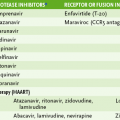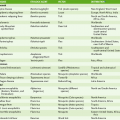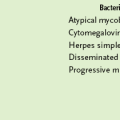Chapter 21 • Midsized viruses with a linear double-stranded DNA genome and naked, icosadeltahedral capsid that has fibers extending from the vertices. 1. Fibers extending from viral capsid bind to specific receptors on epithelial and other cells. 2. Primary lytic infection with accompanying inflammation occurs in mucous membranes of the respiratory tract, gastrointestinal tract, conjunctiva, and cornea. 3. Persistent, latent infection in lymphoid tissues (e.g., tonsils, adenoids, and Peyer patches) is common. B Adenoviral illnesses (Table 21-1) TABLE 21-1 Common Illnesses Associated with Adenoviruses 1. Incubation period for acute adenoviral illness is 4 to 9 days, but virions may be released for long periods, even after resolution of symptoms. 2. Acute, self-limited illness is the most common manifestation of adenoviral infection. 3. Infections occur primarily in children, military recruits, and immunocompromised individuals. 1. Dense, basophilic intranuclear inclusion body within infected cells is diagnostic of adenoviruses. 2. Adenovirus serotypes can be distinguished by immunoassay, DNA probe, or polymerase chain reaction (PCR) analysis of cultured specimens. 1. As naked capsid viruses, adenoviruses are resistant to drying and detergents and are very contagious. 2. Virions are spread via aerosols, fecal-oral route, fomites, and close contact and in inadequately chlorinated swimming pools.
Nonenveloped (Naked) DNA Viruses
Type of illness
Clinical features
Acute febrile pharyngitis
Fever, sore throat, cough, coryza, and other symptoms that may mimic streptococcal infection
Most common in young children (<3 yr)
Acute respiratory disease
Rapid onset of fever, cough, sore throat, rhinorrhea, and cervical adenitis
Occurs mostly in military recruits
Pharyngoconjunctival fever
Similar to acute pharyngitis but accompanied by conjunctivitis (“pink eye”)
Occurs in older children, often in outbreaks associated with use of poorly chlorinated swimming pools
Preauricular lymphadenopathy important diagnostic finding
Atypical pneumonia
Nonproductive cough with pulmonary infiltrates and effusions
Seen in children and adults
Epidemic keratoconjunctivitis
Inflamed pebbled conjunctiva (pink eye) in adults similar to conjunctivitis in children but of longer duration and followed by keratitis
Usually associated with irritation to eye by dust or other debris
Gastroenteritis
Diarrhea with possible vomiting primarily in infants and young children due to serotypes 40-42
Other serotypes (e.g., 25-28) cause diarrhea in hospitalized patients.
Acute appendicitis
Lymphoid hyperplasia in appendix compromises blood supply leading to acute inflammation.
![]()
Stay updated, free articles. Join our Telegram channel

Full access? Get Clinical Tree


Nonenveloped (Naked) DNA Viruses






